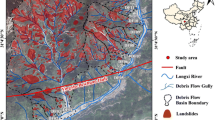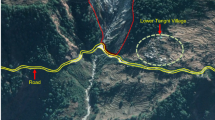Abstract
Debris flows are one of the processes of mass movements that are generated by heavy rains and are activated in the upper parts of the basins. The application case of the present research carried out in the Rio Seco stream in the district of San Bartolomé, located in the Province of Huarochirí, Department of Lima seeks to recreate a debris flow event that occurred on February 2, 2017 as a result of the climatic phenomenon in the Lima Andes. Likewise, it seeks to identify the areas of debris flow threats for different return periods Tr = 100 and Tr = 500 years. For this investigation, the mathematical model is applied using the FLO-2D software, which will process topographic data, rheological properties of the debris fluid and liquid hydrographs in different return periods. Finally, processing the data, results such as flow depth, maximum flow velocities of possible deposition zones, sediment concentration and impact force are obtained. This article is focused on comparing the debris flow and its depth with a real event adjusted with watermark control points. From the simulated results, debris flows were obtained with return periods of Tr = 100 years and Tr = 500 years, flows of 0.4 and 0.5 m3/s, tie rods with flow heights of 1.80 m and 1.90 m, respectively. Additionally, the preliminary threat map was prepared to identify vulnerable areas.
Access this chapter
Tax calculation will be finalised at checkout
Purchases are for personal use only
Similar content being viewed by others
References
Gutiérrez, T.: Climate change and its effects in Peru. Cuban Hygiene Epidemiol. 51(3), 331–337 (2012)
de la Salud, O.P.: El Niño Phenomenon Piura Region, Peru. Chin. Sci. Bull. 36(14), 1081–1084 (2018)
Sosio, R., Crosta, G., Frattini, P.: Field observations, rheological testing and numerical modeling of a debris-flow event. Earth Surf. Proc. Land. 32(2), 290–306 (2007)
Civil, I., Por, P., Rosario, J., Buenaventura, A.: For the Control of Debris Flow Quebrada El Tingo - Pataz - Peru (2019)
Hürlimann, M., et al.: Debris-flow monitoring and warning: review and examples. Earth-Sci. Rev. 199, 102981 (2019)
Quispe, R.L., Vargas, E.P., Jihuallanga, C.A.: Risk level due to overflow and flooding applying a debris flow model in the Quebrada Lluta for the Karla mine in Tacna. Ciencia & Desarrollo 17(23), 11–20 (2019)
Sepúlveda, A.B., Franco, J.P., Rodríguez Pineda, C.E.: Methodology for risk assessment due to debris flow detonated by rain: Útica, Cundinamarca, Colombia case. Obras y proyectos 20, 31–43 (2016)
Morales, L., Sarmiento, C.: Control of erosion and weathering with Guadua on slopes of the municipality of San Francisco Cundinamarca, Tóriba village. Degree work. Catholic University of Colombia. Colombia (2020). https://bit.ly/3IJ9Zow. Accessed 19 June 2022
Cheng, H., Huang, Y., Zhang, W., Xu, Q.: Physical process-based runout modeling and hazard assessment of catastrophic debris flow using SPH incorporated with ArcGIS: a case study of the Hongchun gully. CATENA 212, 106052 (2022)
Castillo, L., Fídel, L.S., Jackson, L.: Mudflow Modeling Using Flo-2d in Quebrada Paihua: impact on the City of Matucana, Lima. In: XIII Peruvian Geology Congress, 17 October 2006. https://bit.ly/3yDjxN8. Accessed 19 June 2022
Mazzorana, B., Huebl, J., Fuchs, S.: Improving risk assessment by defining consistent and reliable system scenarios. Nat. Hazard Ground Syst. Sci. 9(1), 145–159 (2009)
Manual of Hydrology, Hydraulics and Drainage, Ministry of Transport and Communications of Peru (2008). https://bit.ly/3nSDiLD. Accessed 19 June 2022
SENAMHI. SENAMHI, National Meteorology and Hydrology Service of Peru. https://www.senamhi.gob.pe. Accessed 19 June 2022
Fídel, L., Zavala, B., Núñez, S., Valenzuela, G.: Study of geological risks in Peru, Strip No. 4. INGEMMET. Bull. Ser. C Geodyn. Geol. Eng. 29, 383 (2006)
Garcia, R., Lopez, J.L.: Debris flows of December 1999 in Venezuela. In: Debris-Flow Hazards and Related Phenomena, pp. 519–538 (2005). https://doi.org/10.1007/3-540-27129-5_20
FLO-2D Reference Manual (2019). https://bit.ly/3IFhSer. Accessed 30 Aug 2021
Hungr, O., Evans, S.: A Review of the Classification of Landslides of the Flow Type. Environmental & Engineering Geoscience (2001). https://bit.ly/3uLliGY. Accessed 19 June 2022
O’brien, J.S., Julien, P., Fullerton, W.: Two-dimensional water flood and mudflow simulation. J. Hydraul. Eng. 119, 244–261 (1993). https://bit.ly/3RqUZQ5. Accessed 19 June 2022
Gamion, J.: Debris and mud flow model applying FLO 2D, Shullcas river sub-basin case, Thesis, National University of Central Peru (2014). https://bit.ly/3nXmP94. Accessed 1 June 2022
Go, D.-H., Lee, K., Kim, J.-M., Kim, S.-W.: FLO-2D simulation of the flood inundation zone in the case of failure of the Sandae Reservoir Gyeongju, Gyeongbuk. J. Eng. Geol. 25, 449–458 (2015). https://bit.ly/3Pn9suv. Accessed 19 June 2022
Basabe, P., Neumann, A., Singer, A.: Contribution to the Prevention of Natural Disasters in Venezuela. PREVENE, Colombia (2001)
Castro, B.O., Gabrielli, D.E., Rosario, J., Zelada, B.R., Buenaventura, A.: Proposal for a numerical model and alternatives for the control of debris flow in the El Tingo-Pataz-Perú stream, Graduate thesis, Ricardo Palma Private University (2019). https://bit.ly/3yDrMJ9. Accessed 19 June 2022
Acknowledgment
We thank to the engineers Rubén Mogrovejo, Ada Arancibia and Leonardo Castillo for their support and guidance, the Peruvian University of Applied Sciences and professors involved in the preparation process of the present article.
Author information
Authors and Affiliations
Corresponding author
Editor information
Editors and Affiliations
Rights and permissions
Copyright information
© 2024 The Author(s), under exclusive license to Springer Nature Switzerland AG
About this paper
Cite this paper
Castillo S., J., Atala V., A.R., Mogrovejo G., R.E. (2024). Debris Flow Modeling Using FLO-2D for Hazard Identification in the Rio Seco Creek. In: Kim, J., Chen, Z. (eds) Trends in Environmental Sustainability and Green Energy. CGEEE 2023. Springer Proceedings in Earth and Environmental Sciences. Springer, Cham. https://doi.org/10.1007/978-3-031-52330-4_5
Download citation
DOI: https://doi.org/10.1007/978-3-031-52330-4_5
Published:
Publisher Name: Springer, Cham
Print ISBN: 978-3-031-52329-8
Online ISBN: 978-3-031-52330-4
eBook Packages: Earth and Environmental ScienceEarth and Environmental Science (R0)




